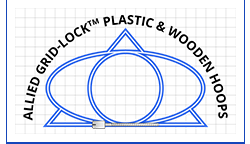Hooping Tips
Here are a few tips for hooping that we have learned over time:
Start by finding the right hoop for the job. Try to use the smallest hoop possible for the job, however make sure that there is enough clearance for the presser foot. When possible, use a round hoop because this provides the most uniform grip and tension of the article being embroidered. Double-height hoops are useful for thicker fabrics as they provide more gripping surface. The natural grain of wooden hoops often provides a better grip on slippery fabrics such as satins and silks.
Use the proper backing for the fabric that you are embroidering on based on the material of the article and the complexity and weight of the design. If possible, use adhesive backing and apply the backing to the article before hooping. This will help keep a strong bond between the fabric and the backing, and will ensure that the backing is in the correct location and is providing proper coverage. This is especially helpful with stretchy fabrics to help prevent against overstretching the fabric while hooping. If it is not possible to use an adhesive backing, another tip is to place the backing on top of the outer ring, fold one corner of the backing over and around so that it reaches onto the inner wall of the outer hoop, and tape it in place to create an anchor point. Do the same on the opposite corner, and the backing should stay in place and have good tension.
To help prevent against hoop burn, place a piece of non-adhesive backing between the fabric and the inner hoop with a window cut out of the backing within which the embroidery will be done. You can make these liners ahead of time based on the size of the hoop(s) that you have and the available sewing area withing the hoop, and you can re-use these liners. For these, use a backing that won't transfer any color or residue onto the garment.
Adjust the outer hoop correctly before pressing in the inner hoop. The inner hoop should not go in very easily, nor should you have to press very hard. If the outer hoop is either too loose or too tight, remove the inner hoop and start over. Try not to adjust the outer hoop after inserting the inner hoop. It will take patience and practice to develop this technique.
Once the item is hooped, check for the tension of the material. If there isn't enough tension, re-hoop the item. Don't excessively pull on the fabric to remove any looseness, as this could lead to stretching of the fabric, distortion of the design and/or puckering.
- Building Blocks of Embroidery | Printwear Magazine, 03/03/2015, Ed Levy
- Hooping 101: Embroidery Basics | Printwear Magazine, 10/14/2014, Alice Wolf & Bonnie Nielson
- How to Hoop Difficult Fabrics | Printwear Magazine, 11/12/2012, Bonnie Nielson
- How to Hoop for Embroidery | Printwear Magazine, 03/15/2010, Bonnie Nielson
- How To Hoop Flawlessly | Printwear Magazine, 09/01/2008, Helen Hart Momsen
- Embroidery-specific stain removal | Printwear Magazine, 12/01/2007, Helen Hart Momsen
- Embroidery on Fleece | Printwear Magazine, 08/01/2009, Helen Hart Momsen
- Expand the Possibilities: Painting with Thread | Printwear Magazine, 11/01/2008, Helen Hart Momsen












